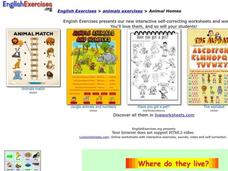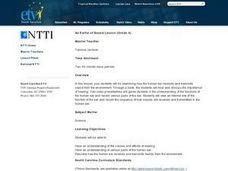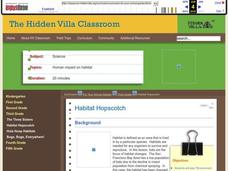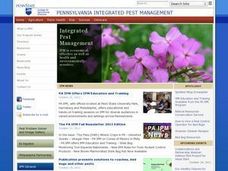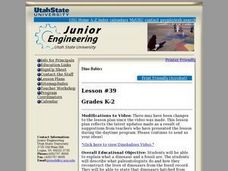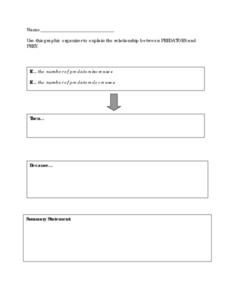Curated OER
How is Atomic Energy Used Today
Students investigate energy sources by examining photographs. In this atomic energy lesson, students identify and describe various pictures and how atomic energy is used in them. Students create a presentation demonstrating how many...
Curated OER
What's Wild?
Third graders define domesticated animal and wildlife. In this animal lesson, 3rd graders cut pictures out of magazines of both types of animals and make two collages with the pictures.
Curated OER
Pond Life
Students recognize the habitats of animals that live near or in a pond. In this pond lesson plan, students examine pond water and look for pond organisms. Students observe organisms with a loupe and complete a worksheet.
Curated OER
Animal Homes
In this animals worksheet, students click the correct animal, click the correct habitat, and click the animals that don't live in a given habitat. Students complete 3 activities.
Curated OER
Insects!
Students explore the diet of insects. In this "insects" biology lesson, students take a nature walk and collect various natural materials they think may be eaten by insects. Students sort and classify these materials into three diet...
Curated OER
Hawaii's Freshwater Ecosystems
Students examine brackish water. In this Science lesson, students observe organisms found in brackish water. Students record their observations of the various organisms.
Curated OER
Insect Camouflage
Students investigate insect camouflage and mimicry. In this animal science lesson, students discuss how camouflage helps an insect survive. Additionally, students use the included template to color and cut illustrations of insects....
Curated OER
Fossil History
Students examine the similarities and differences between living organisms and fossils. In this fossil lesson students reenact the process of creating a fossil.
Curated OER
An Earful of Sound Lesson
Fourth graders examine how the human ear receives and transmits sound from the environment. Through a book, they hear and discuss the importance of hearing. Students view an Internet site of the function of the ear and record the...
Curated OER
Habitat Hopscotch
Third graders explore animal characteristics by participating in a bat environment game. In this natural habitat lesson, 3rd graders identify the physical anatomy of a bat and discuss their eating and sleeping habits. Students conduct a...
Curated OER
Habitat Hopscotch
Students analyze different habitats. In this habitat instructional activity, students evaluate what animals need in their habitats. Students participate in the game Habitat Hopscotch.
Curated OER
Taxonomy Project
Students act as a taxonomist and, given a certain situation, classify existing organisms.
Curated OER
El Nino and Its Effects
Students research El Nino and its effects all over North America using Web Resources. Working in teams, they present their findings. They look for connections and relationships between animal behavior and climate.
Curated OER
The Pests of Summer
Students research insects that act as pests during the summer months. They investigate how to protect themselves and their homes from these pests. They study the life cycle of the cicada.
Curated OER
Bats -- Pests or Pals?
Fourth graders examine a bat and determine if it is a pest or pal. They identify three types of bats native to the state of Pennsylvania. They also identify the parts of a bat and write a report on the bat of their choice.
Curated OER
BIoluminescence
Students investigate the concept of bioluminescence. They use dinoflagellates in a lab situation to study photosynthesis. They conduct research into the concept using a variety of resources. Also the class is taken on a field trip to...
Curated OER
Genetic Disorders with Cultural Roots: International Insects
High schoolers recognize that certain populations have specific genetic disorders that could benefit or harm them in their environment, work out punnett square problems and infer offspring probabilities from results, and provide...
Curated OER
The Global Impact of Insect Borne Diseases & Agriculture
Pupils study the global impact of insect borne diseases, the appropriate use of pesticides, and the concept of human interrelations on a world wide scale. They examine how to safely apply a pesticide, according to the label.
Curated OER
Life Science Investigation
Middle schoolers work to investigate an aspect of life science of interest to them from a list. Using the Internet, they research information and take notes on what to include in their presentation. They share their findings with the...
Curated OER
Arthropod Mouth Parts and Food
Young scholars identify the different types of mouths arthropods have for eating various types of food. Given photographs of the different types of arthropods, students identify which mouth they have and what type of food they can eat...
Curated OER
Dino Babies
Young scholars distinguish between dinosaurs and fossils. They escribe what paleontologists do and how they reconstruct the lives of dinosaurs from the fossil record. In addition, they state that dinosaurs hatched from eggs.
Curated OER
Predator/Prey
Learners explain how the food chain works. They contrast predators with prey and describe their function in nature. Students discuss how the food chain aids in keeping nature balanced. They play a game that simulates the food chain.
Curated OER
Predators and Prey
Pupils explain how the food chain works. They contrast predators with prey and describe their function in nature. Students discuss how the food chain aids in keeping nature balanced. In small groups, they play a game that simulates the...
Curated OER
Diseases
Sixth graders create a type of notebook or journal using colored copy paper on which to take notes. They complete research on a certain disease and report on it and then design their own disease causing bacteria or virus. Finally, 6th...
Other popular searches
- Life Cycle of Mosquito
- Why Mosquitoes Buzz
- Mosquitoes Buzz
- Origami Mosquito
- Why Mosquitoes
- Mosquito Life Cycle
- Cause and Effect Mosquitoes
- Classify Mosquitoes
- Why Do Mosquitoes Buzz
- Anopheles Mosquito
- Mosquitoes Digestive System
- Information on Mosquitoes





